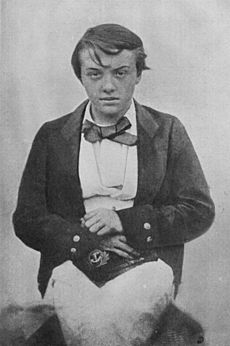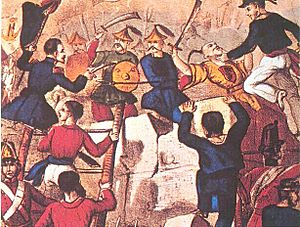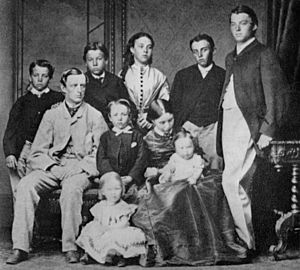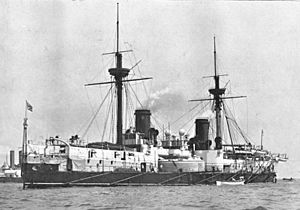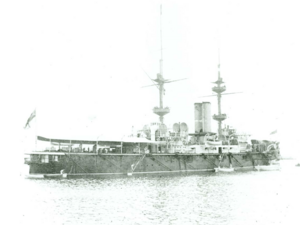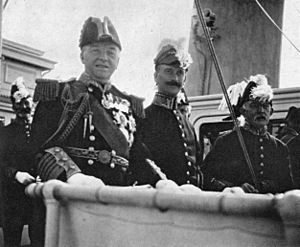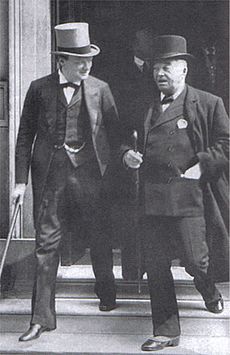John Fisher, 1st Baron Fisher facts for kids
Quick facts for kids
The Lord Fisher
|
|
|---|---|
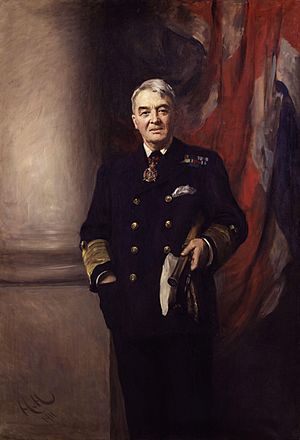
Fisher by Hubert von Herkomer
|
|
| Nickname(s) | Jacky |
| Born | 25 January 1841 Ramboda, Ceylon |
| Died | 10 July 1920 (aged 79) London, England |
| Allegiance | United Kingdom |
| Service/ |
Royal Navy |
| Years of service |
|
| Rank | Admiral of the Fleet |
| Commands held |
|
| Battles/wars | |
| Awards |
|
Admiral of the Fleet John Arbuthnot Fisher, 1st Baron Fisher (25 January 1841 – 10 July 1920), often called Jacky Fisher, was a very important British admiral. He spent over sixty years in the Royal Navy. He worked hard to change the navy, making it much more modern. Thanks to him, old wooden sailing ships with muzzle-loading cannon were replaced by strong steel ships. These included powerful battlecruisers, submarines, and the first aircraft carriers.
Fisher was known for being an innovator and a great planner. He focused on making the navy better, rather than just fighting big battles. Even so, he did experience combat during his long career. In 1904, he became the First Sea Lord, a very high position. He quickly removed 150 old ships that were no longer useful. Then, he started building new, modern ships. He wanted to create a strong fleet ready to face Germany in the First World War.
Fisher understood the need for better naval gunnery. He wanted guns that could shoot farther, more accurately, and faster. He also strongly supported using torpedoes. He believed torpedoes would become more important than big guns for sinking enemy ships. As Controller of the Navy, he introduced torpedo-boat destroyers. These fast ships were designed to defend against torpedo boats and submarines.
Later, as First Sea Lord, he pushed for the building of HMS Dreadnought. This was the first all-big-gun battleship, a revolutionary design. He also believed submarines would be very important and urged their development. Fisher helped bring in turbine engines to replace older engines. He also pushed for ships to use oil instead of coal. He even made sure sailors got fresh, daily baked bread on board ships. Before him, they often ate hard biscuits that were full of biscuit beetles!
He first retired from the Admiralty in 1910 when he was 69. But he returned as First Sea Lord in November 1914. He resigned seven months later because he disagreed with Churchill about the Gallipoli campaign. After that, he led the Government's Board of Invention and Research until the war ended.
Contents
- Who Was Admiral Fisher?
- Fisher's Early Life and Family
- Starting a Naval Career (1854–1869)
- Becoming a Commander (1869–1876)
- Leading Ships as Captain (1876–1883)
- Becoming an Admiral (1890–1902)
- Changing Officer Training (1902–1904)
- First Sea Lord (1904–1910)
- Before and During the War (1911–1915)
- Later Life (1915–1920)
- Fisher's Legacy and Famous Sayings
- Awards and Honors
- See also
Who Was Admiral Fisher?
Fisher was not very tall, about five feet seven inches. He had a round face and was quite strong. Some people thought he might have Asian family roots because of his looks. But his skin color was actually from illnesses he had in his middle life. These illnesses, like dysentery and malaria, almost killed him. When he spoke to someone, he had a very strong, fixed gaze. This made it hard to tell what he was feeling.
Fisher was full of energy, very ambitious, and very smart. One shipmate said he was "the most interesting midshipman I ever met." Sometimes, when he was making a point, he would get very excited. Once, the King even asked him to stop shaking his fist! People saw him as someone who demanded to be heard. He didn't like people who weren't smart or efficient.
He was a religious man throughout his life. He went to church regularly when he was on land. He loved listening to sermons and would sometimes go to two or three services in one day. He would then talk about them with great excitement. But he kept his religious views private. He worried that public attention might hurt his career.
Fisher wasn't a big fan of sports, but he was an excellent dancer. Later in life, he used his dancing skills to charm important ladies. He became interested in dancing in 1877. He even made sure the officers on his ship learned to dance. He would cancel leave for midshipmen who refused to take part. He also started the practice of junior officers dancing on deck. This happened when the band played for senior officers' dinners. This idea spread throughout the navy. He broke the tradition of dancing with a different partner for each dance. Instead, he would choose one good dancer and stay with them all evening. This was quite scandalous at the time! Even though he could be blunt, his charm helped him get along with people from all walks of life. He suffered from seasickness his whole life.
Fisher's main goal was to make the fleet "efficient" and "ready for war instantly." This earned him support from many navy officers. He believed in promoting the most skilled people, not just those who had served the longest. This upset some who were passed over. So, he divided the navy into two groups: those who liked his new ideas and those who didn't. As he got older and more senior, he became more bossy. He once said, "Anyone who opposes me, I crush."
He believed that countries fought wars for money or power. He thought that having a strong navy would stop other countries from attacking. This would make war less likely. He famously said, "On the British fleet rests the British Empire." Fisher also believed that a sea battle was much riskier than a land battle. A war could be won or lost in a single day at sea. Lost ships could not be replaced quickly. But an army could be rebuilt faster. When Germany and Britain started building more ships, the German Kaiser said, "I admire Fisher. I say nothing against him. If I were in his place I should do all that he has done."
Fisher's Early Life and Family
John Arbuthnot Fisher was born on 25 January 1841. This happened on the Wavendon Estate in Ramboda, Ceylon (now Sri Lanka). He was the oldest of eleven children. Only seven of them lived past infancy. His parents were Sophie and Captain William Fisher. His father was a British Army officer. He had served as an aide-de-camp (a personal assistant) to a former governor of Ceylon.
John's father sold his army position the year John was born. He became a coffee planter and later a police superintendent. But he got into a lot of debt. He could barely support his growing family. When John was six, he was sent to England. He lived with his grandfather in London. His grandfather had also lost money. The family survived by renting out rooms in their house. John's younger brother, Frederic William Fisher, also joined the Royal Navy and became an admiral. His youngest brother, Philip, became a navy lieutenant. Sadly, Philip drowned in an 1880 storm.
John's father died in a riding accident when John was 15. John's relationship with his mother suffered because they were separated. He never saw her again. But he continued to send her money until she died.
Fisher married Frances Katharine Josepha Broughton, known as 'Kitty', on 4 April 1866. They were married in Portsmouth. Kitty's two brothers were also naval officers. A cousin said that Kitty believed Jack would rise "to the top of the tree." They stayed married until her death in July 1918. They had one son, Cecil Vavasseur, and three daughters: Beatrix Alice, Dorothy Sybil, and Pamela Mary. All of their daughters married naval officers who became admirals.
Fisher's father helped him join the navy. His godmother, Lady Horton, asked Admiral Sir William Parker to nominate John. Parker was the last of Nelson's captains. John officially joined the Royal Navy on 13 July 1854, at age 13. He started on Nelson's old flagship, Victory, in Portsmouth. On 29 July, he joined HMS Calcutta, an old wooden ship. It had 84 guns and used only sails. The ship had 700 crew members. Discipline was very strict. Fisher saw eight men being flogged (whipped) on his first day. He fainted from the shock.
Calcutta helped block Russian ports during the Crimean War. This earned Fisher the Baltic Medal. The ship returned to Britain a few months later. On 2 March 1856, Fisher was sent to HMS Agamemnon. He arrived in Constantinople (now Istanbul) as the war was ending. After a short tour, Agamemnon returned to England.
Fisher became a midshipman on 12 July 1856. He joined HMS Highflyer, a steam corvette, part of the China Station. He spent the next five years in China. He saw action in the Second Opium War (1856–1860). The Highflyer's captain, Charles Shadwell, was an expert in naval astronomy. He taught Fisher a lot about navigation. This helped Fisher greatly later in his career.
Fisher passed his exam to become a lieutenant. He was given the acting rank of mate on his nineteenth birthday, 25 January 1860. Three months later, he moved to HMS Chesapeake as an acting lieutenant. Soon after, Fisher had his first short command. He took the admiral's yacht, HMS Coromandel, from Hong Kong to Canton (now Guangzhou). This trip took four days.
On 12 June 1860, he moved to HMS Furious. Here, he saw enough action to earn clasps for the Taku Forts and Canton on his China War Medal. Furious left Hong Kong in March 1861. It returned to Portsmouth on 30 August.
In November 1861, Fisher took his final lieutenant's exam in navigation. He passed with excellent results. He had already earned top grades in seamanship and gunnery. He got 963 out of 1,000 marks in navigation. This was the highest score at the time. For this, he won the Beaufort Testimonial, a prize of books and instruments.
From January 1862 to March 1863, Fisher worked at the navy's main gunnery school. This was aboard HMS Excellent, a large ship in Portsmouth harbor. During this time, Excellent tested new Armstrong breech-loading guns. These were compared to older Whitworth muzzle-loading guns. Fisher spent 15 of the next 25 years at Portsmouth. He worked on developing gunnery and torpedoes.
In March 1863, Fisher became Gunnery Lieutenant on HMS Warrior. This was the first all-iron armored battleship. It was the most powerful ship in the fleet. It had both Armstrong (breech-loading) and Whitworth (muzzle-loading) guns. Fisher was popular because he often stayed on board, taking duty for other officers.
Fisher returned to Excellent in 1864 as a gunnery instructor. He stayed there until 1869. He became very interested in torpedoes, which were new in the 1860s. He believed they were a simple weapon that could sink battleships. Because of his torpedo knowledge, he was invited to Germany in June 1869. He met King William I of Prussia (who soon became German emperor), Bismarck, and Moltke. This visit might have inspired him to write a paper on how to design and manage electrical torpedoes. This was cutting-edge technology then.
Becoming a Commander (1869–1876)
On 2 August 1869, Fisher was promoted to commander at the young age of twenty-eight. On 8 November, he became second-in-command of HMS Donegal. This ship traveled between Portsmouth and Hong Kong. During this time, he finished his paper on torpedoes.
In May 1870, Fisher moved to HMS Ocean. This was the main ship of the China Station. While on Ocean, he wrote an eight-page paper called "Naval Tactics." He also installed a system that allowed all guns to fire at the same time. This made Ocean the first ship with this feature. Fisher wrote that he missed his wife and his work on torpedoes. He also missed being able to meet important people in England.
In 1872, he returned to England. He went back to the gunnery school Excellent. This time, he led the torpedo and mine training. He separated the Torpedo Branch from Excellent. He created a new place for it called HMS Vernon. His job included giving lectures and buying the navy's first Whitehead torpedo. To promote the school, he invited politicians and journalists to lectures and demonstrations. Some officers didn't like his showmanship. He was promoted to captain on 30 October 1874, at age thirty-three. He became Vernon's first commander. In 1876, Fisher served on the Board of Admiralty's torpedo committee.
Leading Ships as Captain (1876–1883)
From March 1877 to June 1878, Fisher commanded HMS Bellerophon. This was the main ship for the Admiral of the North America and West Indies Station. The ship's crew was not very good at first. Fisher told them, "I intend to give you hell for three months." He meant he would train them very hard. A midshipman later said Fisher was very demanding. But he always rewarded them after hard work.
Fisher then moved to HMS Hercules and HMS Valorous. He was still the main captain for Admiral Cooper Key. During this time, Fisher became interested in a new compass. It was designed by Sir William Thomson. This compass could correct for the metal in iron ships.
From January to July 1879, Fisher commanded HMS Pallas in the Mediterranean. The Pallas was in poor condition. It even had a chain wrapped around it to hold the armor plates in place! He visited Istanbul and dined with the sultan of the Ottoman Empire. He then returned to the UK for leave.
His next job, starting in September 1879, was on HMS Northampton. This was a new ship with many new features. It had twin propellers, searchlights, and telephones. It also had torpedoes. It was fitted with an experimental Thomson compass. Fisher worked hard to improve his ship. His second-in-command said the ship did 150 torpedo runs in two weeks. The rest of the navy did only 200 in a year!
Fisher's brother Philip was on the training ship Atalanta. The ship disappeared in a storm. Northampton was one of the ships sent to search for her, but they found nothing. In January 1881, Fisher was appointed to the new battleship HMS Inflexible.
Leading the Inflexible
Fisher was chosen to be captain of the new battleship HMS Inflexible. Inflexible had the biggest guns and thickest armor in the navy. But it still had masts and sails. Its guns were slow to load. The ship took seven years to build. It had many new features, like electric lighting and torpedo tubes. But its layout was so confusing that the crew got lost! The sails were never used for power. But Fisher had to drill the crew in using them. This was because a ship's performance was partly judged by how fast it could set sails.
In spring 1882, Inflexible was part of the Mediterranean Fleet. It protected Queen Victoria during her visit to France. This was meant to show French leaders how powerful the British navy was. It also allowed Fisher to meet Queen Victoria and her grandson, Prince Henry of Prussia. Prince Henry later became an admiral in the German navy. Queen Victoria was impressed by Fisher.
Inflexible took part in the 1882 Anglo-Egyptian War. It helped bombard the port of Alexandria. Fisher was put in charge of a landing party. He came up with a clever plan to armor a train with iron plates, a machine gun, and a cannon. This train became famous and was widely reported by journalists. This made Fisher known to the public as a hero for the first time. But his time on shore made him very sick with dysentery and malaria. He refused to take sick leave. But eventually, he was ordered home. A leader said, "the Admiralty could build another Inflexible, but not another Fisher."
During this time, he became a close friend of the future King Edward VII and Queen Alexandra. He was given the award of Companion of the Bath (CB) in 1882.
Working at Home
From January to April 1883, Fisher was recovering from his illness. Queen Victoria invited him to visit her home, Osborne House. Fisher, who had started in the navy with no money and no connections, was thrilled.
In April 1883, Fisher was well enough to return to duty. He was appointed commander of HMS Excellent. He stayed there for two years. He gathered a group of officers who were worried about the fleet's poor fighting ability. This group included John Jellicoe and Percy Scott. For the next 15 months, he had no naval command and was still affected by his illness. He started visiting Marienbad, a famous place for its healing climate. He went there regularly in later years.
From November 1886 to 1890, he was the Director of Naval Ordnance. This meant he was in charge of weapons and ammunition. He helped develop quick-firing guns to fight against the growing threat from torpedo boats. He also took credit for removing wooden boarding pikes from navy ships. The navy did not control the making and supply of weapons. This was handled by the War Office. Fisher began a long effort to give this responsibility back to the Admiralty. He finally succeeded when he became First Sea Lord. He was appointed Aide-de-Camp to the Queen in 1887. He was promoted to Rear-Admiral in August 1890.
Becoming an Admiral (1890–1902)
From May 1891 to February 1892, Fisher was Admiral Superintendent of the dockyard at Portsmouth. He focused on making operations faster. For example, Royal Sovereign was built in two years instead of three. Changing a gun on a ship was reduced from a two-day job to two hours. His example made all shipyards work faster. This saved money and allowed new ship designs to be used more quickly. He used many tricks. If an official wouldn't leave his office to supervise work, Fisher would offer him a promotion to a hot climate. He would learn the names of a few workers and then praise them by name. This made it seem like he knew everyone. He once brought a chair and table into the yard and said he would stay there until a job was done. He said, "When you are told a thing is impossible... then is the time to fight like the devil."
His next job was Third Naval Lord and Controller of the Navy. This officer was in charge of providing ships and equipment. He oversaw the development of torpedo boat destroyers. These ships had quick-firing, small-calibre guns. Fisher suggested calling them destroyers. In 1892, Alfred Yarrow of Thornycroft and Yarrow shipbuilders suggested building these boats. He said he had plans for new French torpedo boats. He could build faster boats to defend against them. Torpedo boats were a big threat. They were cheap but could sink large battleships. France had built many of them. The first destroyers were successful, and more were ordered.
Fisher was knighted in 1894 as a Knight Commander of the Bath. He was promoted to vice-admiral in 1896. Then, he was put in charge of the North America and West Indies Station in 1897. In 1898, there was a threat of war with France during the Fashoda Crisis. Fisher planned to raid French islands and free Alfred Dreyfus to cause trouble in the French army. Fisher's policy was to do all training exercises at full speed. He expected the best from his crews. He would spend time with junior officers so they felt comfortable sharing ideas.
Prime Minister Lord Salisbury chose Fisher to represent Britain at the First Hague Peace Convention in 1899. This conference was called to limit weapons. But Britain wanted to keep its navy strong. Fisher didn't say much in formal meetings. But he worked hard behind the scenes at informal gatherings. He impressed many people with his friendly style and strong determination. The conference ended with limits only on certain bullets, poison gas, and bombing from balloons. Fisher was rewarded by being put in charge of the Mediterranean Fleet. This was considered "the tip-top appointment of the fleet." The German delegation understood Britain's position. They knew Britain's world power depended on its navy. The navy was strong enough to beat any group of countries. And England wanted the right to use its fleet however it chose.
Leading the Mediterranean Fleet
The Mediterranean Fleet was a very important British command. It operated from Alexandria and Gibraltar. The important shipping route between India and Britain went through the Suez Canal. France was seen as a threat to this route. Fisher kept his main ship from the North American Squadron, HMS Renown. He chose it even though it was not as powerful as traditional battleships.
His plan was to strike first in a battle. But he also knew that sunk ships could not be easily replaced. He would replace any officer who couldn't meet his high standards. He gave lectures on naval strategy to all officers. He encouraged them to bring him new ideas. He offered prizes for essays on tactics. He also had a large map room with models of all ships. Officers could use this to develop tactics. He was especially worried about the threat of torpedoes. Germany had boasted that torpedoes would destroy the British fleet. France also had many torpedo boats. Fisher's new ideas were not liked by everyone. Some senior officers didn't like the attention he gave to junior officers. They also didn't like the pressure he put on everyone to be more efficient.
He started realistic training exercises. These included fake French raids, defensive moves, night attacks, and blockades. All were done at top speed. He created a gold cup for the ship with the best gunnery. He insisted on shooting at longer ranges and from battle formations. He learned how complex it was to control a large fleet. He enjoyed it very much.
His lectures showed that at first, heavy guns could only shoot effectively at 2000 yards. With special sights, they could reach 3000–4000 yards. But by the end of his time, they were discussing how to shoot effectively at 5000 yards. This was because torpedoes could now reach 3000–4000 yards. Ships needed to fight from farther away. He believed that ships should be designed for how they would fight. He told officers, "Think and act for yourself is the motto for the future, not Let us wait for orders."
Fisher held many banquets and balls for important guests. This helped improve diplomatic relations. The fleet visited Constantinople. He met the sultan three times. He received the Grand Cordon, Order of Osmanieh in November 1900. The next year, he was promoted to full Admiral on 5 November 1901. He worked hard to get more ships and supplies for the Mediterranean squadron.
Changing Officer Training (1902–1904)
In June 1902, Fisher left the Mediterranean Squadron. He returned to the UK to become Second Naval Lord. This meant he was in charge of naval personnel (the people in the navy). He started his new job on 10 June.
At this time, engineering officers were very important because ships used more machinery. But command officers often looked down on them. Fisher thought it would be better if the two groups could be combined. This had been done before with navigation officers. His idea was to combine the training for both types of officers. He also changed the school lessons. This way, cadets would have a good base to go into either path. Other leaders at the Admiralty first disagreed. But Fisher convinced them that the changes would be good. It was harder to stop objections from the rest of the navy. A campaign against the changes started in newspapers. Fisher knew how important it was to have the press on his side. He continued to give information to friendly journalists.
Training was made longer, from less than two years to four years. This meant more places were needed for cadets. A second training school, the Royal Naval College, Osborne, was built. Cadets spent their first two years there. The last two years were still at Dartmouth. All cadets now learned science and technology related to ships. They also learned navigation and seamanship. Command officers would now understand their ships better. Engineers would be better prepared for command roles. Physical education and sports were also taught. This was not just for the cadets. It was also to prepare ships' crews to form sports teams for visits to foreign ports.
Entry to the navy used to be by examination. This favored those who could afford special tutoring. Fisher replaced this with an interview committee. This committee looked at a candidate's general knowledge. They also watched how candidates reacted to questions. After four years, cadets went to special training ships. They got practical experience before getting real command jobs. The final exam results affected each cadet's seniority. This also affected their chances of early promotion.
Fisher said his plan, called the Selborne-Fisher scheme, could not be stopped. He meant it was too good to fail. However, his original plan included the Royal Marines. This caused fewer cadets to want to become officers in that branch. So, Fisher had to change his reforms in 1912 to exclude the Royal Marines.
He was given the award of Knight Grand Cross of the Order of the Bath (GCB) in 1902. King Edward VII presented it to him.
In 1903, he became Commander-in-Chief, Portsmouth. His main ship was HMS Victory.
First Sea Lord (1904–1910)
Fisher became First Sea Lord on 20 October 1904. This was a very important job. He was given a house in London. He also rented Langham House, Ham for his family. In June 1905, he was given the Order of Merit (OM). In December, he was promoted to Admiral of the Fleet.
Fisher was brought to the Admiralty to cut naval spending. He also needed to prepare the navy for modern war. He boldly sold off 90 old and small ships. He put another 64 into reserve. He called them "too weak to fight and too slow to run away." He also called them "useless junk." This freed up sailors and money. This allowed him to build more large, modern ships for home waters. The navy's budget for 1905 was reduced by £3.5 million. This was despite new building programs and much greater effectiveness. Naval spending fell from 1905 to 1907. By the end of Fisher's time as First Sea Lord, spending was back to 1904 levels.
He was a key person behind the development of the fast, all-big-gun battleship. He led the committee that designed the first modern battleship, HMS Dreadnought. His committee also designed a new type of cruiser. It was similar to Dreadnought but very fast. It achieved high speed by having less armor. This became the battlecruiser. The first one was HMS Invincible. He also encouraged the Royal Navy to use submarines. He pushed for the navy to switch from using mostly coal to using oil for fuel. He had a long-running public disagreement with another admiral, Charles Beresford.
As First Sea Lord, Fisher suggested to King Edward VII that Britain should use its strong navy to attack the German fleet at Kiel. This would be a surprise attack without declaring war. It was like what the Royal Navy did against the Danish Navy during the Napoleonic Wars. Fisher later wrote that he was "the most hated man in Germany." This was because the German Emperor had heard of Fisher's idea to attack the German Fleet.
In 1908, he predicted that war between Britain and Germany would happen in October 1914. This turned out to be true. He based this on when the Kiel Canal would be widened. This would allow Germany to move its large warships safely between the Baltic and the North Sea. He was appointed a Knight Grand Cross of the Royal Victorian Order (GCVO) that year.
On 7 December 1909, he was made Baron Fisher. His motto was "Fear God and dread nought." This was a clever play on words, referring to his famous ship, Dreadnought.
Before and During the War (1911–1915)
Fisher retired on 25 January 1911, his 70th birthday. He moved to Kilverstone Hall.
In 1912, Fisher became chairman of the Royal Commission on Fuel and Engines. His goal was to change the entire fleet to use oil. His reports were kept "Secret." They were submitted in November 1912, February 1913, and February 1914.
When the First World War began in August 1914, Fisher often visited Churchill at the Admiralty.
In October 1914, Lord Fisher was called back as First Sea Lord. This happened after Prince Louis of Battenberg had to resign because of his German name. The Times newspaper reported that Fisher was "never younger or more vigorous" even at 74. He resigned on 15 May 1915. This was due to strong disagreements with Winston Churchill, the First Lord of the Admiralty, over the Gallipoli campaign. Fisher's resignation also caused Churchill to resign.
Fisher was not always keen on the Gallipoli campaign. He changed his mind often, which frustrated cabinet members. He preferred a water-based attack on the German Baltic Sea coastline. This was called the Baltic Project. He even had special shallow-draft battlecruisers built for this purpose. These were HMS Furious, HMS Glorious, and HMS Courageous. As the Gallipoli campaign failed, his relationship with Churchill got worse. One of Fisher's last ideas for ships was the HMS Incomparable. This was a huge battlecruiser with 20-inch guns but very little armor. It was never built.
Fisher's resignation was not taken seriously at first. The Prime Minister, H. H. Asquith, said, "Fisher is always resigning." But Fisher left his office at the Admiralty. He said he was going to retire to Scotland. The Prime Minister then ordered him, in the King's name, to continue his duties. Senior naval officers and the press asked the elderly (74) First Sea Lord to stay. Fisher replied with an unusual letter to Asquith. He listed six demands that would "guarantee the successful termination of the war." These demands would have given him complete control over the fleet. This included all promotions and ship building. Asquith thought Fisher's behavior showed signs of mental trouble. He then quickly accepted Fisher's original resignation.
Later Life (1915–1920)
Fisher became chairman of the Government's Board of Invention and Research. He served in this role until the end of the war. In 1917, he received a high Japanese award, the Order of the Rising Sun with Paulownia Flowers, Grand Cordon.
Admiral Fisher's wife, Frances, died in July 1918. Her ashes were buried in St Andrew's churchyard, near Kilverstone Hall. Her coffin was covered with Fisher's flag as Admiral of the Fleet.
Fisher died of cancer in London on 10 July 1920, at age 79. He was given a national funeral at Westminster Abbey.
His coffin was pulled on a gun-carriage through London's streets. Sailors pulled it, and six admirals were pall-bearers. Royal Marines marched with their arms reversed, to the slow beat of muffled drums. That evening, his body was cremated. The next day, Fisher's ashes were taken by train to Kilverstone. A Royal Navy guard of honor escorted them. His ashes were placed in his wife's grave, under a chestnut tree. It overlooked the figurehead of his first seagoing ship, HMS Calcutta.
Fisher's Legacy and Famous Sayings
- A hidden message about Fisher was found in a court judgment in 2006. It was in the Da Vinci Code plagiarism case. The judge, Mr Justice Peter Smith, was a "Jackie Fisher fan."
- Fisher is known for using the abbreviation "OMG" for "Oh my God." He used it in a letter to Winston Churchill in 1917.
- Fisher created the phrase "Buggins' turn." This describes promoting people based on who has served longest, not who is best. He thought this was a problem in the navy.
- The song "Old Admirals" by Al Stewart is mostly about Fisher's life.
- Fisher appears as a midshipman in the novel Flashman and the Dragon (1985).
- He also appears in the TV mini-series Reilly: Ace of Spies (1983).
Awards and Honors
 Knight Commander of the Order of the Bath (1894)
Knight Commander of the Order of the Bath (1894) Knight Grand Cross of the Order of the Bath (1902)
Knight Grand Cross of the Order of the Bath (1902) Order of Merit (1905)
Order of Merit (1905) Knight Grand Cross of the Royal Victorian Order (1908)
Knight Grand Cross of the Royal Victorian Order (1908) Grand Cross of the Legion of Honour (1906)
Grand Cross of the Legion of Honour (1906) Order of Osmanieh (1900)
Order of Osmanieh (1900) Order of the Rising Sun with Paulownia Flowers, Grand Cordon (1917)
Order of the Rising Sun with Paulownia Flowers, Grand Cordon (1917)
See also
 In Spanish: John Arbuthnot Fisher para niños
In Spanish: John Arbuthnot Fisher para niños



